
After a long while, we’re back!
I apologise for this delay, however I’m afraid it might happen again: Internet in not everywhere, here is much easier to find a good Cabernet than a web connection! If you’re a reader eager to know about what’s happening, this lack of information may be frustrating: At the same time it gives me more room to write about the best experiences and the most amusing tales.
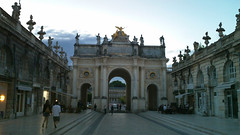 We left our story in the outskirts of Nancy: At first glance I really liked this city. I can now confirm and reinforce the enthusiasm for a community that seems very committed in preserving the environment and offering a good lifestyle to all its citizens, beginning from the means of moving.
We left our story in the outskirts of Nancy: At first glance I really liked this city. I can now confirm and reinforce the enthusiasm for a community that seems very committed in preserving the environment and offering a good lifestyle to all its citizens, beginning from the means of moving.
 The network of public transport is well-distributed and the electric tram reaches most of the suburbs. Methane fueled buses and a well managed traffic make of Nancy a very clean and pleasant city. We’re welcomed by Sylvain, who works and studies here. He speaks a good English, however we strive to speak French.
The network of public transport is well-distributed and the electric tram reaches most of the suburbs. Methane fueled buses and a well managed traffic make of Nancy a very clean and pleasant city. We’re welcomed by Sylvain, who works and studies here. He speaks a good English, however we strive to speak French.
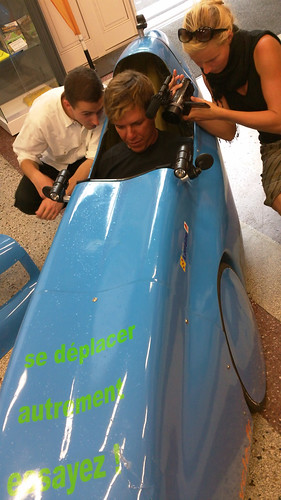 His hospitality and help have revealed priceless, beginning from La Maison de Velo, a fantastic idea by Dominique Xailly that two years ago, along with the municipality of Nancy, has founded a centre where bikes are nearly a religion!
His hospitality and help have revealed priceless, beginning from La Maison de Velo, a fantastic idea by Dominique Xailly that two years ago, along with the municipality of Nancy, has founded a centre where bikes are nearly a religion!
Here the bicycles can be rented (just 80 euros yearly for a variety of models), bought, washed. There’s a library of books and DVD about bike trips, a meeting room and much more. We also have the pleasure of meeting Pierre who finds bizarre and extraordinary bikes, such as the bike-car resembling a 60′s racing car. Bruno tries it, bute I can’t even get in!
Then, a new surprise: Atelier Dynamo, a centre created a few years ago by Thomas and other friends to retrieve spare parts of discarded bikes, assembling them to make new bicycles. The members, they are more than 1.000, can afford to buy a bike by spending as little as 25 to 50 euros.
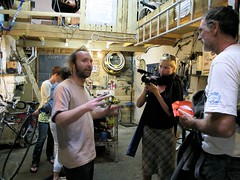 Thomas also organises events and tours, and the lab in rue des Tiercelins 18, can be freely used by all members to fix their bikes. A good idea worth to be followed.
Thomas also organises events and tours, and the lab in rue des Tiercelins 18, can be freely used by all members to fix their bikes. A good idea worth to be followed.
Our stay in Nancy is rich in meeting interesting people, such as Paul Rougieux, an engineer specialised in timber and its technical properties, who gives us a wonderful cherry jam handmade by his mum.
 The next day Paul takes us to meet his uncle Guy Rougieux, president of the syndicate of waters from the Seille and Moselle rivers. Guy has spent many years working on the water-supply system for the villages around Nancy. We follow him in a plateau housing a very interesting network: Here we visit a central where chlorine is added to drinking water by law, following the events of 2001 and the fear for terrorist attacks.
The next day Paul takes us to meet his uncle Guy Rougieux, president of the syndicate of waters from the Seille and Moselle rivers. Guy has spent many years working on the water-supply system for the villages around Nancy. We follow him in a plateau housing a very interesting network: Here we visit a central where chlorine is added to drinking water by law, following the events of 2001 and the fear for terrorist attacks.
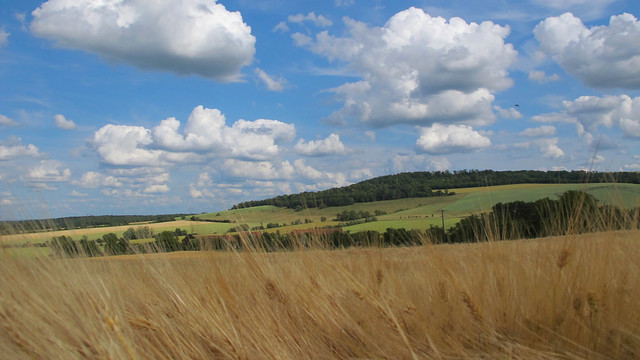
The landscape surrounding us is beautiful.
 Guy’s help is precious and will be even more important very soon: We develop a very strong friendship. In the evening we’re invited for dinner in his home in Lanfroincourt, 130 inhabitants, where we also visit La Pepiniere (the plant-nursery) of Etienne, Paul’s dad, and pick the same cherries used to make Paul’s mum’s jam. Paul tells us about the current hard times for quality plant-nurseries in Lorraine, after the invasion of low-cost plants.
Guy’s help is precious and will be even more important very soon: We develop a very strong friendship. In the evening we’re invited for dinner in his home in Lanfroincourt, 130 inhabitants, where we also visit La Pepiniere (the plant-nursery) of Etienne, Paul’s dad, and pick the same cherries used to make Paul’s mum’s jam. Paul tells us about the current hard times for quality plant-nurseries in Lorraine, after the invasion of low-cost plants.
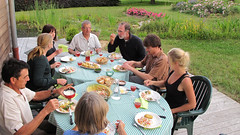 The dinner cooked by René, the nice wife of Guy, is special, full of delicious Lorraine specialties such as the Pâté Lorrain and the classic Quiche Lorraine. In the end Guy gives us a Mirabelle Brandy and René some magic cherries.
The dinner cooked by René, the nice wife of Guy, is special, full of delicious Lorraine specialties such as the Pâté Lorrain and the classic Quiche Lorraine. In the end Guy gives us a Mirabelle Brandy and René some magic cherries.
Thanks once more to these wonderful friends from Lorraine.
 The morning after, in the Port de Plaisance of Nancy we meet the director, Captain Franck Rosseaux, who tells us about this showpiece harbour and his commitment to protect the environment through initiatives aimed to reduce the waste of water and the leakage of bilge water and greywater (collecting them for free).
The morning after, in the Port de Plaisance of Nancy we meet the director, Captain Franck Rosseaux, who tells us about this showpiece harbour and his commitment to protect the environment through initiatives aimed to reduce the waste of water and the leakage of bilge water and greywater (collecting them for free).
We leave Nancy grateful for all the generous people that we had the fortune to meet.
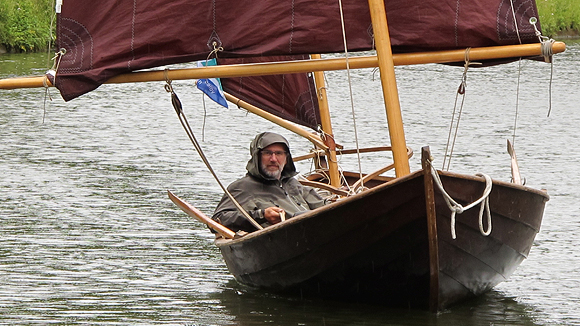
The following days are very wet.
After nearly a month of fairly good weather, the rain comes to visit and we keep getting followed by little thunderstorms. We enjoy a few fantastic sails: Bruno is very good at exploiting the wind corridors between the trees, and Clodia flyies so fast with a good bone in her teeth.
 In Varangeville, site of the famous salt mines, despite the heavy rain I approach a Peniche showing my best smile and asking for a good coffee shop.
In Varangeville, site of the famous salt mines, despite the heavy rain I approach a Peniche showing my best smile and asking for a good coffee shop.
Two women have pity on me and my wretched conditions due to a very wet 13 kilometres of rowing, and invite me on board.
 Quite soon, in the usual cozy and warm way of people who live aboard, we get feed with a substantial breakfast and guided for a tour of Saint Nicolas de Port.
Quite soon, in the usual cozy and warm way of people who live aboard, we get feed with a substantial breakfast and guided for a tour of Saint Nicolas de Port.
It’s a great discovery: We visit a gothic basilica of rare beauty (housing Europe’s highest columns, one of them crying, and the right hand of Saint Nicholas, the patron saint of sailors), an hospital for storks, that here nest everywhere, and a beer museum where they offer us a catalogue.
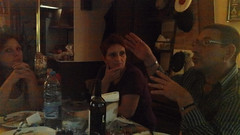 Anouk and her husband Dany also makes us dinner and we get overwhelmed by their warmth and friendliness. We have a wonderful time: Thanks Anouk and Dany, you gave us a special day to remember. The next morning the sun pops out and we get moving greeting our hosts with the usual sadness.
Anouk and her husband Dany also makes us dinner and we get overwhelmed by their warmth and friendliness. We have a wonderful time: Thanks Anouk and Dany, you gave us a special day to remember. The next morning the sun pops out and we get moving greeting our hosts with the usual sadness.
On the way to Strasbourg we meet a friend of Anouk, Dominique, who lives on a beautifully restored Peniche, along with her mum, two sweet dogs, many cats and a great passion for frienship.
 She tells us the story of the town of Dombasle and its abandoned harbour, victim of the obtuseness of politics and of the vandals that have wasted a structure that could have been of great help for this area. Here there is a Solvay big industrial plant, who might have limited the long term view of the governants.
She tells us the story of the town of Dombasle and its abandoned harbour, victim of the obtuseness of politics and of the vandals that have wasted a structure that could have been of great help for this area. Here there is a Solvay big industrial plant, who might have limited the long term view of the governants.
 After Dombasle, Clodia, Bruno and me enjoy exhilarating sails under a continuous rain followed by moments of sunshine: It’s a very Atlantic looking weather with sudden changes. In Lagarde we sleep in a lovely harbour, passing the evening in conversation about life.
After Dombasle, Clodia, Bruno and me enjoy exhilarating sails under a continuous rain followed by moments of sunshine: It’s a very Atlantic looking weather with sudden changes. In Lagarde we sleep in a lovely harbour, passing the evening in conversation about life.
The landscape is always changing. Now we’re on a plateau with the canal many metres above the horizon, now in a kind of green tunnel.
The nature is alive and untouched everywhere, and there are many forests. Water is not as transparent as in Toul but stil of a nice green and rich of fishes: chars, trouts (introduced), perches and many sheatfishes, we get told.
 After a great sail helped by 40 km/h windblasts, we reach and pass the lock of Richecourt, who was for many years the highest French lock, from its 15.4 metres of height.
After a great sail helped by 40 km/h windblasts, we reach and pass the lock of Richecourt, who was for many years the highest French lock, from its 15.4 metres of height.
Impressive, most of all the noise of the sash door closing behind us. The rise is about half an hour long but everything is well and we get off by sailing with the mizzen (the smaller sail).
We stop for the night in Gondrexange leaving in the morning for Hesse where, moored under a nice maple tree, we entre the office of Le Boat, a company renting houseboats.
Thanks to Angelina, the kind secretary, we get to know thet being a rowboat we can’t get past under the two next tunnels and overall on the Arzviller inclined plane, a marvel of hydraulic engineering. How depressing!!
 But never say never. The next day two friendly employed from VNF, our notorious guardian angels, after hearing me whining against the refuse coming from Strasbourg headquarter, decide to go to Nederviller by boat. They’ll try to plead the cause of our humble oar’s crusade in the local VNF office: Not an easy task.
But never say never. The next day two friendly employed from VNF, our notorious guardian angels, after hearing me whining against the refuse coming from Strasbourg headquarter, decide to go to Nederviller by boat. They’ll try to plead the cause of our humble oar’s crusade in the local VNF office: Not an easy task.
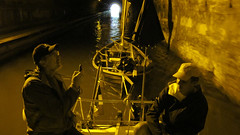 When they come back the no becomes a yes, assuming to get towed by an engine boat. Giving that the total distance to be covered is no longer than 6 km, we’re happy to accept this offer: Moreover any other means of transport would have been very hard to arrange and against our philosophy. So little Serena tows us.
When they come back the no becomes a yes, assuming to get towed by an engine boat. Giving that the total distance to be covered is no longer than 6 km, we’re happy to accept this offer: Moreover any other means of transport would have been very hard to arrange and against our philosophy. So little Serena tows us.
The inclined plane of Saint-Louis Arzviller is a great emotion.
Looking at this “swimming pool” of 900 tons of weight that gently slides for 44 metres (with the boats inside!) is remarkable. And it’s energy free since the pools are moved up and down by the weight difference. Brilliant!
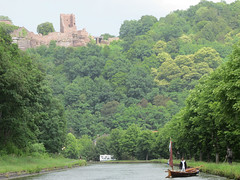 After Saint-Louis Arzviller we enter a completely different world: Beech and coniferous forests, red rocks, castles, german architecture, a steep descent to Strasbourg. We’re in the Vosges.
After Saint-Louis Arzviller we enter a completely different world: Beech and coniferous forests, red rocks, castles, german architecture, a steep descent to Strasbourg. We’re in the Vosges.
After a quick stop in Lutzelbourg (it seems bizarre to find an harbour in a village resembling the italian Alps), we stop overnight beside an houseboat lived by a few german guys, loud and a little drunk, in an enchanted valley.
When the fist shades of the evening begin to fall, we see a white silhouette waving its arms and talking to the germans. Già comò… Già comò, it says, and I think: “What happened? They’re coming to arrest me because we’ve past the tunnels without an official permission. Now they’ve changed their mind… I’ll get known as the “Man in Jail”…
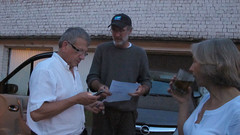 But I’m safe, it’s Guy who carries good news: He’s sold his soul to give us some interesting contacts in Strasbourg, where he has worked for many years and knows lots of people. He already arranged us a meeting with the mayor of a village who will be of great help. Guy is a saint who gave us help and passion. We’re touched, thanks.
But I’m safe, it’s Guy who carries good news: He’s sold his soul to give us some interesting contacts in Strasbourg, where he has worked for many years and knows lots of people. He already arranged us a meeting with the mayor of a village who will be of great help. Guy is a saint who gave us help and passion. We’re touched, thanks.
 Our journey so far has seen 200 locks, 8 tunnels, 13 suspended canals and we’re approaching the milestone of 1000 km, about 1/5th of the total itinerary.
Our journey so far has seen 200 locks, 8 tunnels, 13 suspended canals and we’re approaching the milestone of 1000 km, about 1/5th of the total itinerary.
By arms and oars (with a little sail) they’re a lot. Trying is believing!
We’re now in Saverne, that’s wonderful. It’s raining cats and dogs after a promising arrival, thanks to the meeting with Volker and Ilka, that tonight have invited us for a pizza handmade in their boat, a Dutch Tjalk.

 The mood is high and the bones wet. But water is life and local beer is also very tasty. We’re in Alsace, by the way, and wines are excellent too! In short, cheer up to fluids.
The mood is high and the bones wet. But water is life and local beer is also very tasty. We’re in Alsace, by the way, and wines are excellent too! In short, cheer up to fluids.
See you soon and a big hug. Giacomo
P.S.: A special thanks to Caroline Bouguereau who has helped us so much with press relations in France.

 There are the wild landscapes of the Marne side-canal, postcard-worthy. Herd of cattle running away at our approach, shaking the earth under their feet. And water, of course. We drink it straight from the canal: It’s potable and transparent down to 4 metres.
There are the wild landscapes of the Marne side-canal, postcard-worthy. Herd of cattle running away at our approach, shaking the earth under their feet. And water, of course. We drink it straight from the canal: It’s potable and transparent down to 4 metres.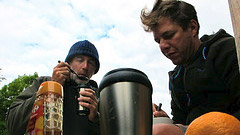 There are breakfasts in the midst of the steam rising from the canals, rain-wet nights, burnt days, opposite winds, handshakes from calloused hands, honest and warm hands. Kisses thrown in the air by a Turkish kid that keeps greeting us from the distance, so happy to read that word… Istanbul!
There are breakfasts in the midst of the steam rising from the canals, rain-wet nights, burnt days, opposite winds, handshakes from calloused hands, honest and warm hands. Kisses thrown in the air by a Turkish kid that keeps greeting us from the distance, so happy to read that word… Istanbul!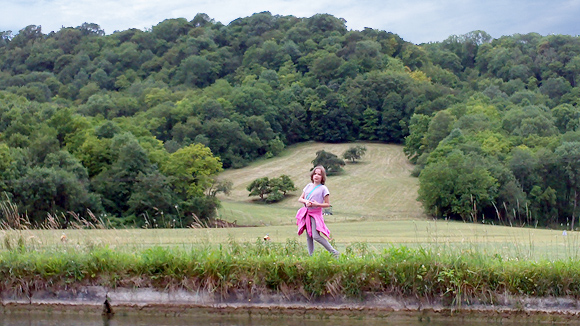
 There’s the old hearth of
There’s the old hearth of 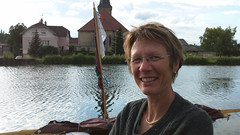 Such as Chantal in Treveray, that takes me to join the rest of the crew (I was left behind to update the website, and a long walk was in front of me), and the Mayor of Treveray who helps me to send an important e-mail to the italian radio;
Such as Chantal in Treveray, that takes me to join the rest of the crew (I was left behind to update the website, and a long walk was in front of me), and the Mayor of Treveray who helps me to send an important e-mail to the italian radio;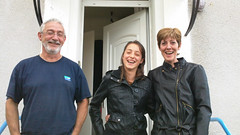 And Jean, an “eclusier” (lock-keeper), a profession that’s quickly disappearing due to the automations required by the cost-cuts. He invites us in his home, offering Champagne, along with his charming wife and his nice daughter that the next day makes us a gift: A postcard depicting this very same lock many years ago;
And Jean, an “eclusier” (lock-keeper), a profession that’s quickly disappearing due to the automations required by the cost-cuts. He invites us in his home, offering Champagne, along with his charming wife and his nice daughter that the next day makes us a gift: A postcard depicting this very same lock many years ago; And yet again Sara and Bertrand in Toul that take us aboard their boat for breakfast, also making us sandwiches for the next day.
And yet again Sara and Bertrand in Toul that take us aboard their boat for breakfast, also making us sandwiches for the next day. The landscape is now hilly: We’ve got up and down more than 110 times, passing 25 locks in just one day. The journey is intense, it’s so difficult to pay justice to all the places in such a short report, however I’ll try to put together a summary of what’s happened in the past week.
The landscape is now hilly: We’ve got up and down more than 110 times, passing 25 locks in just one day. The journey is intense, it’s so difficult to pay justice to all the places in such a short report, however I’ll try to put together a summary of what’s happened in the past week.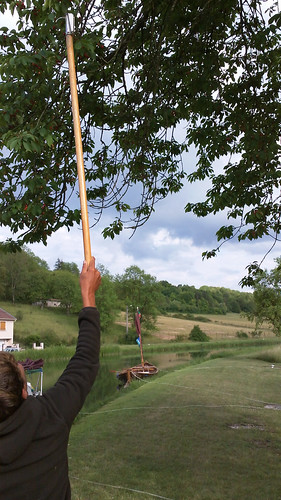 In Treveray, we moor under a cherry tree and Josephine jumps over Bruno’s shoulders to pick a few of these tasty fruits (we’re now officially gatherers, although still nomadic at heart!).
In Treveray, we moor under a cherry tree and Josephine jumps over Bruno’s shoulders to pick a few of these tasty fruits (we’re now officially gatherers, although still nomadic at heart!).
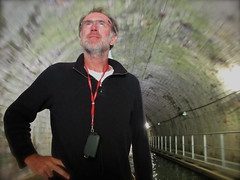 But we’re waited by the second long tunnel of our journey, that of Mauvages, just slightly shorter than the Suterrain de Riqueval. This tunnel was built from the 1841 to the 1846: It’s about 4.800 metres long, wet and dark, and equipped with the same system used in Riqueval, an electric towboat. But Captain Jack and his crew are already accustomed to this!
But we’re waited by the second long tunnel of our journey, that of Mauvages, just slightly shorter than the Suterrain de Riqueval. This tunnel was built from the 1841 to the 1846: It’s about 4.800 metres long, wet and dark, and equipped with the same system used in Riqueval, an electric towboat. But Captain Jack and his crew are already accustomed to this! We stop for the night in Void, where Elvis from Vnf gives us a pen. The next morning we have breakfast over a roman bridge with a baguette cooked in a wood-fired oven. Then we get to Toul, fortified city, meeting Jean, Sara and Bertrand in a new, magnificent harbour. Here we visit the wonderful Cathedral: What a chance to show off my long-past architecture study with Bruno and Fine!
We stop for the night in Void, where Elvis from Vnf gives us a pen. The next morning we have breakfast over a roman bridge with a baguette cooked in a wood-fired oven. Then we get to Toul, fortified city, meeting Jean, Sara and Bertrand in a new, magnificent harbour. Here we visit the wonderful Cathedral: What a chance to show off my long-past architecture study with Bruno and Fine!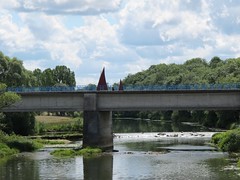 We get aboard once again heading to Nancy, sailing over the bridge-canal on the Meuse and rowing under another long tunnel: After 36 km we eventually enter in a real river, the Moselle.
We get aboard once again heading to Nancy, sailing over the bridge-canal on the Meuse and rowing under another long tunnel: After 36 km we eventually enter in a real river, the Moselle.
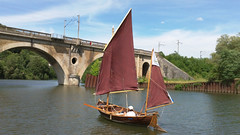 France is still sweet. Despite the Kilometres already travelled, 800 so far, we’re convinced to run too fast, leaving behind so many things and missing opportunities.
France is still sweet. Despite the Kilometres already travelled, 800 so far, we’re convinced to run too fast, leaving behind so many things and missing opportunities.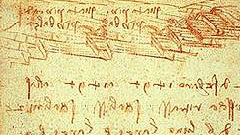 Among those, there was a gentleman called Leonardo, coming from a tiny village in Tuscany, Vinci. By chance, he had dedicated great energies and efforts in the study of water and waterways. His water stair starting in Pavia has been left in a totally neglected condition.
Among those, there was a gentleman called Leonardo, coming from a tiny village in Tuscany, Vinci. By chance, he had dedicated great energies and efforts in the study of water and waterways. His water stair starting in Pavia has been left in a totally neglected condition.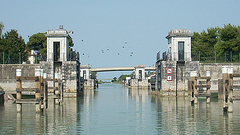 I’m also sorry because at every lock passed, we’re at 157 so far, I can see the doors that Leonardo invented five centuries ago, and are so called “vincian”. They’re still working beautifully all around the world.
I’m also sorry because at every lock passed, we’re at 157 so far, I can see the doors that Leonardo invented five centuries ago, and are so called “vincian”. They’re still working beautifully all around the world.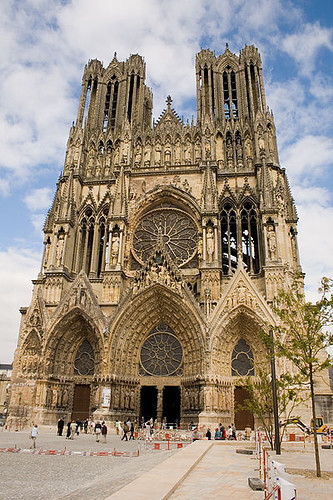
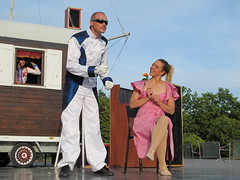 Fine will stop here a little longer to make a video about one of them, Magali. You can watch the final result at bottom page, it’s way better than a thousand words.
Fine will stop here a little longer to make a video about one of them, Magali. You can watch the final result at bottom page, it’s way better than a thousand words. The permission from VNF doesn’t arrive and I show to Mr Michel Marteau the e-mail sent to their Lille’s offices. A firm “No” turns at first to a “Maybe” and then, following a phone call full of laughs (it’s not every day that you meet two madmen rowing to Istanbul), to a very warm and participative “Yes”.
The permission from VNF doesn’t arrive and I show to Mr Michel Marteau the e-mail sent to their Lille’s offices. A firm “No” turns at first to a “Maybe” and then, following a phone call full of laughs (it’s not every day that you meet two madmen rowing to Istanbul), to a very warm and participative “Yes”.
 Our arrival in Reims is quite funny. The canal flows in the very hearth of the city, between two high-traffic roads: A real mayhem. Everybody stare at us like we’re from another planet, maybe martians (o humans…). Paradox in all of this mess, we cross the first other rowboat in France: two guys in a double scull.
Our arrival in Reims is quite funny. The canal flows in the very hearth of the city, between two high-traffic roads: A real mayhem. Everybody stare at us like we’re from another planet, maybe martians (o humans…). Paradox in all of this mess, we cross the first other rowboat in France: two guys in a double scull.
 We discovered that its name comes from “Remus”, funnily the Italian word for “oar”, brother of Romulus founder of Rome!! According to the (obviously roman) legend, Remus founded Reims giving his name to the first people living in the area too. Even today the inhabitants are called Rémois.
We discovered that its name comes from “Remus”, funnily the Italian word for “oar”, brother of Romulus founder of Rome!! According to the (obviously roman) legend, Remus founded Reims giving his name to the first people living in the area too. Even today the inhabitants are called Rémois.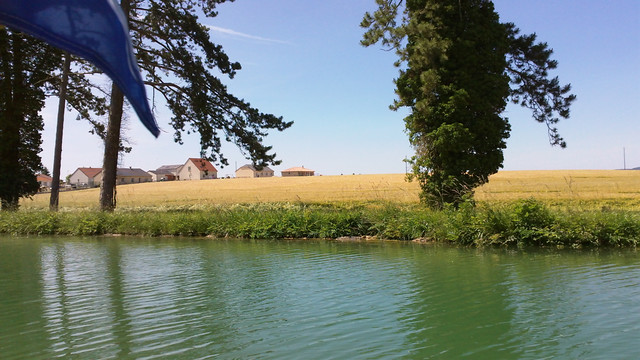
 This leg is very hard and made even harder by the opposite wind. Thanksfully we take comfort from a few wild strawberries picked on the banks of the canal from aboard Clodia. Sweat and sweets!!
This leg is very hard and made even harder by the opposite wind. Thanksfully we take comfort from a few wild strawberries picked on the banks of the canal from aboard Clodia. Sweat and sweets!!  In Port de Vaudemanges we’ll have one of the best time of our rich journey. In a perfect environment, a small “liveaboard” community has chosen to restore old boats and get free from brick houses. They seem happier. Isabelle, judge, welcomes us and in a blink of an eye we arrange a collective dinner for many friends.
In Port de Vaudemanges we’ll have one of the best time of our rich journey. In a perfect environment, a small “liveaboard” community has chosen to restore old boats and get free from brick houses. They seem happier. Isabelle, judge, welcomes us and in a blink of an eye we arrange a collective dinner for many friends. One of them, Maddy Lecyn, has restored a Peniche belonging to Serge and Isabelle, equipping it with a recording studio, a place of arts that he’s now planning to take around Europe to carry aboard artists, music and beauty. His website is
One of them, Maddy Lecyn, has restored a Peniche belonging to Serge and Isabelle, equipping it with a recording studio, a place of arts that he’s now planning to take around Europe to carry aboard artists, music and beauty. His website is  On board, James cooks fantastic prawns and Paolo improvises a tipical Italian meal: Spaghetti (that he has brought from home, of course) for 10 people. In a 5.74 mt long boat, I can tell you that cooking is not that easy.
On board, James cooks fantastic prawns and Paolo improvises a tipical Italian meal: Spaghetti (that he has brought from home, of course) for 10 people. In a 5.74 mt long boat, I can tell you that cooking is not that easy.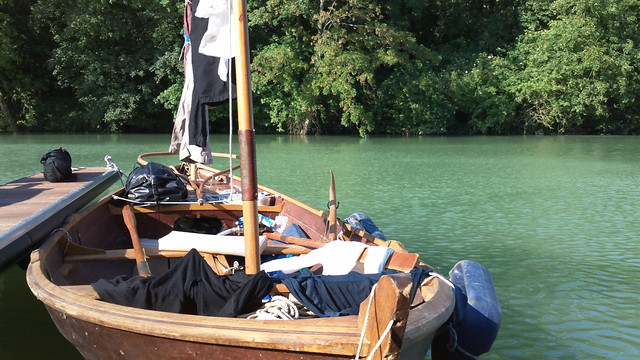
 It’s time to go, to try, to live the journey. And to let Clodia slide over the waters to Istanbul.
It’s time to go, to try, to live the journey. And to let Clodia slide over the waters to Istanbul.























